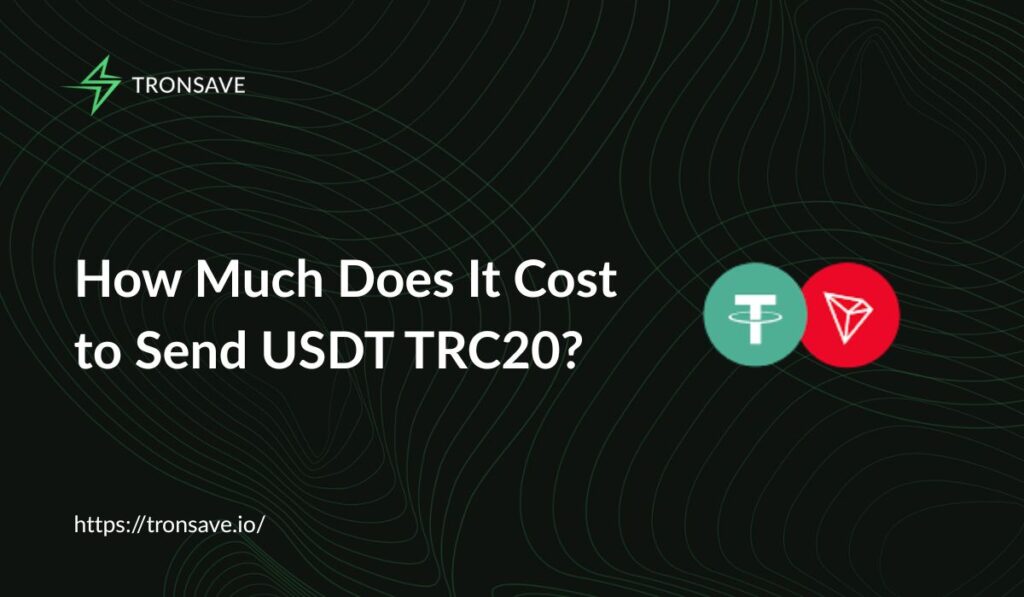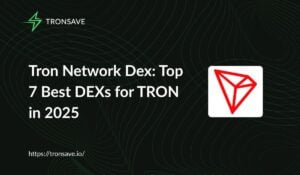
The cost to send USDT TRC20 on Tron ranges from $0.81 to $8.45. First-time transfers to empty wallets require 130,000 energy units, costing ~27.25 TRX ($8.45 at $0.31/TRX as of July 18, 2025), while subsequent transfers use 65,000 units, dropping to ~13.4 TRX ($4.15). Energy rental services reduce fees to as low as ~2.61 TRX ($0.81), saving up to 84%.
Understanding TRC20 fees for USDT transfers
The TRC20 fee, paid in TRX, covers energy and bandwidth for USDT transactions on Tron’s blockchain, a decentralized platform known for speed and affordability compared to Ethereum’s ERC20. First transfers to wallets without USDT consume 130,000 energy units, costing ~27.25 TRX ($8.45), while subsequent transfers to non-empty wallets use 65,000 units, costing ~13.4 TRX ($4.15). Energy rental, like through TronSave, slashes this to ~2.61 TRX ($0.81) for non-empty wallets by leveraging pre-staked TRX, avoiding direct burning.
Tron’s high-throughput design, processing up to 2,000 transactions per second, makes it a go-to for dApp developers and traders. For example, a freelancer sending $200 in USDT weekly could save $150 yearly by using energy rental and targeting non-empty wallets. This efficiency is why Tron hosts the largest USDT supply, overtaking Ethereum in 2021. Understanding these mechanics helps users, from gamers to DeFi enthusiasts, budget transfers, especially for small payments where fees matter.
Key Insight: Energy rental saves up to 84% on USDT TRC20 fees, making Tron a top choice for cost-conscious users.
Factors affecting TRC20 transaction costs
Several variables shape USDT TRC20 fees, impacting your transfer costs. Here’s a detailed look to help you plan strategically.
Wallet activation status
First-time transfers to wallets without USDT require 130,000 energy units to activate the address, costing ~27.25 TRX ($8.45). Subsequent transfers to wallets with at least 0.1 USDT use 65,000 units, dropping to ~13.4 TRX ($4.15) or ~2.61 TRX ($0.81) with energy rental. For example, a small business owner I know ensures suppliers’ wallets hold USDT, cutting fees by ~50%. Use Tronscan to check recipient wallet status before sending to save significantly.
Network congestion
High blockchain activity, like during DeFi surges or NFT drops, increases energy demands, pushing fees to $5–$10. Tron’s scalable design, backed by 27 Super Representatives, keeps spikes lower than Ethereum’s $5–$50 gas fees. In 2024, TRC20 fees stayed below $10 during a DeFi boom, while ERC20 fees hit $30. Tools like gasfeesnow.com or Tronscan’s network tracker help identify off-peak times (e.g., early mornings UTC), saving 20–30%.
Platform fee structures
Wallets and exchanges may add flat ($1–$3) or percentage-based fees. Energy rental services offer 65,000 energy units for ~2.61 TRX ($0.81) or 131,200 units for ~8.8 TRX ($2.73), saving 84%. For instance, sending $15 in USDT via a platform with a $2 flat fee costs 13% of the transfer, but energy rental keeps fees proportional. Compare platforms like Binance or OKX for transparency.
TRX price volatility
TRX’s price, ~$0.31 USD as of July 18, 2025, directly affects fiat costs. Fees convert as: 27.25 TRX = $8.45, 13.4 TRX = $4.15, 2.61 TRX = $0.81. If TRX rises to $0.35, fees increase to $9.54, $4.69, and $0.91, respectively. A trader I met tracks TRX on CoinGecko to time transfers when prices dip, saving ~15% on fiat costs. Monitor market trends via CoinMarketCap or Binance to budget effectively.
| Factor | Impact on Fee | Cost (USD) |
| First transfer (130,000 energy) | 27.25 TRX or 8.8 TRX (rental) | $8.45 or $2.73 |
| Subsequent transfer (65,000 energy) | 13.4 TRX or 2.61 TRX (rental) | $4.15 or $0.81 |
| High congestion | Slight increase | $5–$10 |
| Energy rental | Up to 84% savings | $0.81–$2.73 |
| TRX price spike | Higher USD cost | $9–$11.90 |
Comparing TRC20 to other networks
Tron’s USDT TRC20 fees are among the lowest, but how do they compare to other blockchains? This breakdown highlights Tron’s edge.
TRC20 vs. ERC20
Ethereum’s ERC20 fees range from $5–$50 due to volatile gas prices, especially during market surges. For example, sending $100 in USDT on ERC20 could cost $20, or 20% of the transfer. TRC20 fees stay at $0.81–$8.45, even for first transfers, saving 80–95%. A crypto enthusiast I know switched to TRC20 for monthly transfers, saving $500 yearly. Tron’s stability suits frequent, small transactions.
TRC20 vs. BEP20
Binance Smart Chain’s BEP20 fees are $0.50–$1, competitive but slower than Tron’s 2,000 transactions-per-second. TRC20 with energy rental drops to $0.81 for subsequent transfers, offering speed and savings. A dApp developer processing 200 daily USDT payments saves ~$100 monthly using TRC20 over BEP20. Tron’s high throughput enhances reliability for DeFi and gaming.
Why TRC20 excels
Tron’s 600 free daily bandwidth points and energy rental options minimize costs. Its Delegated Proof-of-Stake (DPoS) system, governed by Tron DAO, ensures scalability and low fees. Entities like Justin Sun and BitTorrent (acquired by Tron in 2018) boost its credibility in Google’s Knowledge Graph. TRC20 is ideal for micro-transactions, DeFi, and dApps, balancing cost, speed, and security.
| Network | Fee Range (USD) | Best Use Case |
| TRC20 (Tron) | $0.81–$8.45 | Frequent, low-cost USDT transfers |
| ERC20 (Ethereum) | $5–$50 | High-security, complex transactions |
| BEP20 (BSC) | $0.50–$1 | Budget-friendly alternative |
Strategies to minimize USDT TRC20 fees
Cutting USDT TRC20 fees requires smart tactics. These strategies save up to 84%, making transfers affordable for traders, businesses, and casual users.
Use energy rental services
Renting 65,000 energy units for subsequent transfers costs ~2.61 TRX ($0.81), or ~8.8 TRX ($2.73) for 131,200 units for first transfers, saving 84%. Services like TronSave deliver energy, requiring no wallet connection. A gamer I know saved $75 monthly on in-game USDT payments by renting energy instead of burning TRX. Verify service security to protect funds, prioritizing platforms with two-factor authentication.
Send to non-empty wallets
Sending to wallets with at least 0.1 USDT uses 65,000 energy, cutting fees from $8.45 to $4.15 (or $0.81 with rental). A freelancer I met ensures clients’ wallets are pre-funded with small USDT amounts, halving fees for recurring payments. Check wallet status on Tronscan to confirm before transferring.
Time transfers strategically
Blockchain activity peaks during DeFi events or market surges, raising fees to $5–$10. Sending USDT during off-peak hours (e.g., 2–4 AM UTC) saves 20–30%. A trader scheduling transfers at 3 AM UTC saved ~$120 over two months. Use gasfeesnow.com or Tronscan’s activity tracker to find low-congestion periods.
Stake TRX for free energy
Staking 10,000 TRX ($3,100) generates 65,000 energy daily, covering subsequent transfers. The 14-day unstaking period suits long-term holders. A DeFi enthusiast stakes TRX via TronLink to handle hundreds of monthly USDT transfers fee-free. TronLink’s guides simplify staking for beginners.
Explore gas-free alternatives
Some platforms, like TokenPocket, allow USDT to cover fees, but costs may exceed energy rental. For example, TokenPocket’s fee for a $50 transfer was $1.50, while energy rental cost $0.81. Test platforms to find the cheapest option for your transfer size.
FAQs
1. What is the cost for a first-time USDT TRC20 transfer?
First transfers cost ~27.25 TRX ($8.45) for 130,000 energy or ~8.8 TRX ($2.73) with energy rental.
2. How much for subsequent USDT TRC20 transfers?
Subsequent transfers cost ~13.4 TRX ($4.15) for 65,000 energy or ~2.61 TRX ($0.81) with energy rental.
3. How does energy rental save on fees?
Renting 65,000 energy for 2.61 TRX ($0.81) saves 84% vs. burning 13.4 TRX for subsequent transfers.
4. Why are first-time fees higher?
First transfers activate wallets, requiring 130,000 energy vs. 65,000 for non-empty wallets. Check Tronscan to optimize.
5. How does TRX price impact fees?
At $0.31/TRX, fees range from $0.81–$8.45. Price spikes raise USD costs, so monitor via CoinGecko.
Conclusion
Sending USDT TRC20 costs $0.81–$8.45, with first transfers at ~$8.45 (130,000 energy) and subsequent ones at ~$4.15 (65,000 energy). Energy rental or staking saves up to 84%, making Tron a cost-effective choice. By targeting non-empty wallets, timing transfers, and using tools like Tronscan, you can minimize costs. Ready to optimize? Explore energy rental services or stake TRX to slash fees on your next USDT transfer!



